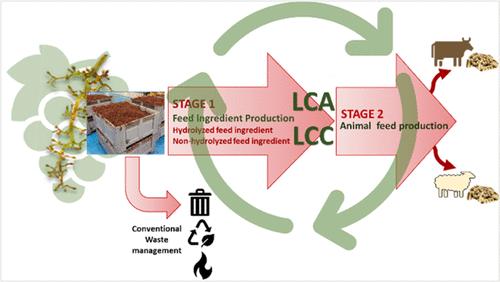评估环境和经济可持续性:用于动物饲料生产的葡萄茎的价值
IF 7.3
1区 化学
Q1 CHEMISTRY, MULTIDISCIPLINARY
引用次数: 0
摘要
本研究从环境生命周期和经济角度评估了葡萄茎(GS)作为动物饲料原料的创新策略。比较了两种基于GS的饲料原料生产工艺:一种使用水解GS,另一种使用非水解GS,以及传统的动物饲料生产工艺。利用基于gis的饲料原料生产的主要中试数据和动物饲料生产的次要数据,进行了生命周期评估和经济分析。结果表明,水解GS对人类健康的影响是未水解GS的3.8倍,主要是由于NaOH和电力使用,尽管这种差异在动物饲料生产阶段可以忽略不计。研究发现,加入基于gs的饲料成分可以减少动物饲料对环境的影响,这主要是由于其他成分的减少。在经济上,生产非水解的基于gs的饲料原料被证明是更可行的,对于一个产能为1000公斤/天的工厂来说,净现值为106,766欧元。与垃圾填埋和堆肥相比,GS增值方案对环境的影响较小,但与具有显著能量回收潜力的焚烧相比,影响较小。本研究建议在畜牧业中采用GS增值来支持循环经济,为利益相关者提供见解。本文章由计算机程序翻译,如有差异,请以英文原文为准。

Assessing Environmental and Economic Sustainability: Valorizing Grape Stems for Animal Feed Production
This study evaluated an innovative strategy for valorizing grape stems (GS) from the winery industry as an animal feed ingredient from both environmental life-cycle and economic perspectives. Two processes for GS-based feed ingredient production were compared: one using hydrolyzed GS and the other using nonhydrolyzed GS, alongside the conventional animal feed production process. Using primary pilot-scale data for GS-based feed ingredient production and secondary data for animal feed production, life-cycle assessments, and economic analyses were conducted. Results showed that hydrolyzing GS leads to 3.8 times higher impacts on human health compared to the nonhydrolyzed variant, primarily due to NaOH and electricity usage, although this difference becomes negligible at the animal feed production stage. Incorporating GS-based feed ingredients was found to reduce the environmental impacts of animal feeds, primarily due to reductions in other ingredients. Economically, producing nonhydrolyzed GS-based feed ingredient proved more feasible, with a net present value of €-106,766 for a plant with a capacity of 1000 kg/d. GS valorization scenarios yield lower environmental impacts than landfilling and composting, although not compared to incineration, which offers notable energy recovery potential. This study suggests adopting GS valorization in animal husbandry to support a circular economy, providing insights for stakeholders.
求助全文
通过发布文献求助,成功后即可免费获取论文全文。
去求助
来源期刊

ACS Sustainable Chemistry & Engineering
CHEMISTRY, MULTIDISCIPLINARY-ENGINEERING, CHEMICAL
CiteScore
13.80
自引率
4.80%
发文量
1470
审稿时长
1.7 months
期刊介绍:
ACS Sustainable Chemistry & Engineering is a prestigious weekly peer-reviewed scientific journal published by the American Chemical Society. Dedicated to advancing the principles of green chemistry and green engineering, it covers a wide array of research topics including green chemistry, green engineering, biomass, alternative energy, and life cycle assessment.
The journal welcomes submissions in various formats, including Letters, Articles, Features, and Perspectives (Reviews), that address the challenges of sustainability in the chemical enterprise and contribute to the advancement of sustainable practices. Join us in shaping the future of sustainable chemistry and engineering.
 求助内容:
求助内容: 应助结果提醒方式:
应助结果提醒方式:


